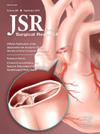Predicting Functional Outcomes in Adult Traumatic Brain Injuries Using the Base Deficit, International Normalized Ratio, and Glasgow Coma Scale Score
IF 1.7
3区 医学
Q2 SURGERY
引用次数: 0
Abstract
Introduction
Up to 70% of early deaths in traumatic brain injuries are due to withdrawal of care. However, many of these patients could have made a good recovery. A reliable prognostic indicator would thus be useful for early decision-making. We sought to determine the association between the Base Deficit, International Normalized Ratio, and Glasgow Coma Scale (GCS) (BIG) score and functional outcomes within 1 y postinjury.
Methods
A meta-analysis was conducted using the Federal Interagency Traumatic Brain Injury Research Informatics System. Two multicenter prospective studies from 2006 to 2018 were selected. Patients over 17 y old were categorized on if they had a BIG score >8 24 h postadmission and a Glasgow Outcome Scale Extended (GOS-E) <5 1 y postinjury. Univariate and multivariate logistic regressions yielded odds ratios and 95% confidence intervals.
Results
In total, 329 patients were identified. One hundred forty-seven patients had a GOS-E <5 while 182 had a GOS-E ≥5. The median BIG score at 24 h was 11.5 for patients with a GOS-E <5 and 6.8 with a GOS-E ≥5 (P < 0.001). A BIG score >8 predicted poor 1-y functional outcomes (OR = 5.29, P < 0.001). The BIG score had a greater sensitivity than GCS (75.5% and 70.7%, respectively) and a comparable negative predictive value (76.2% and 77.1%, respectively).
Conclusions
The BIG score is a promising prognostic tool to predict short-term functional outcome in patients with traumatic brain injury. It has a greater ability than GCS to identify patients that may have poor functionality and is comparable discriminating between good and poor functional outcomes.
使用基础缺陷、国际标准化比率和格拉斯哥昏迷评分预测成人外伤性脑损伤的功能结局
高达70%的创伤性脑损伤早期死亡是由于缺乏护理。然而,这些病人中的许多人本可以很好地康复。因此,可靠的预测指标将有助于早期决策。我们试图确定基础缺陷、国际标准化比率和格拉斯哥昏迷量表(BIG)评分与损伤后1年内功能结局之间的关系。方法采用联邦机构间创伤性脑损伤研究信息系统进行meta分析。选取2006 - 2018年的两项多中心前瞻性研究。17岁以上的患者根据入院后24小时是否有BIG评分和损伤后51小时是否有格拉斯哥结局量表扩展(GOS-E)进行分类。单因素和多因素logistic回归得出优势比和95%置信区间。结果共检出329例患者。147例患者GOS-E≥5,182例患者GOS-E≥5。GOS-E≥5的患者24小时BIG评分中位数为11.5分,GOS-E≥5的患者为6.8分(P <;0.001)。BIG评分>;8预示1-y功能预后较差(OR = 5.29, P <;0.001)。BIG评分的敏感性高于GCS(分别为75.5%和70.7%),阴性预测值也高于GCS(分别为76.2%和77.1%)。结论BIG评分是一种很有前景的预测外伤性脑损伤患者短期功能结局的预后工具。与GCS相比,它具有更强的能力来识别可能功能不良的患者,并且在良好和不良功能预后之间具有可比性。
本文章由计算机程序翻译,如有差异,请以英文原文为准。
求助全文
约1分钟内获得全文
求助全文
来源期刊
CiteScore
3.90
自引率
4.50%
发文量
627
审稿时长
138 days
期刊介绍:
The Journal of Surgical Research: Clinical and Laboratory Investigation publishes original articles concerned with clinical and laboratory investigations relevant to surgical practice and teaching. The journal emphasizes reports of clinical investigations or fundamental research bearing directly on surgical management that will be of general interest to a broad range of surgeons and surgical researchers. The articles presented need not have been the products of surgeons or of surgical laboratories.
The Journal of Surgical Research also features review articles and special articles relating to educational, research, or social issues of interest to the academic surgical community.

 求助内容:
求助内容: 应助结果提醒方式:
应助结果提醒方式:


